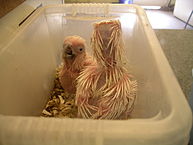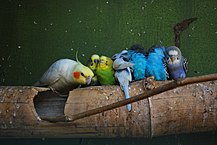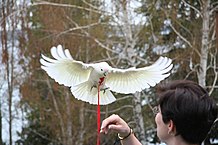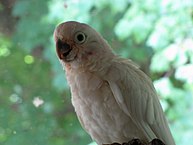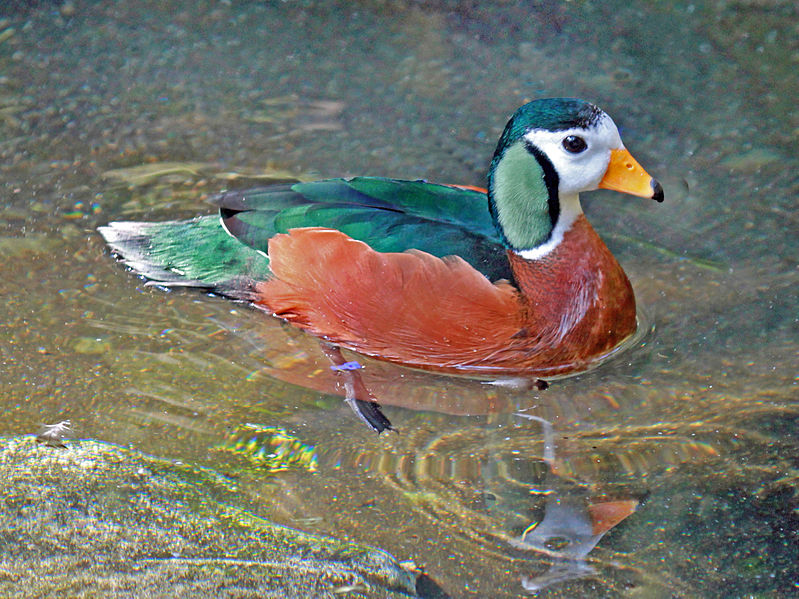This month (July, 2014) the Netherlands became the first country to outlaw the hand-rearing of parrots. The law covers all Psittacines, including parakeets, cockatoos and lovebirds, and imposes fines and/or jail time upon violators. Bird breeders and private owners may not remove nestlings from their parents before the young are feeding on their own and otherwise independent; species-specific time frames are set out in the legislation. The process of hand-rearing, long touted as a means of bonding parrots to people, has been linked to a host of behavioral and health problems. While several countries extend similar protections to young dogs, cats and monkeys, the Dutch law is the first to include birds.
Bird breeders and owners worldwide are lining up for and against this ground-breaking law, and discussions have sometimes become heated. Where do you stand? Please let me know by posting your thoughts and opinions below.
Health Concerns (Physical and Mental)
While hand-reared parrots initially bond readily to their caretakers and so seem ideally-suited for life as companion birds, research conducted at the Netherlands’ Clinic for Birds (please see article below) suggests that problems often arise as the birds mature. Groups that have long lobbied for this law, including the Dutch Parrot Foundation, argue that parent-rearing is essential to such intelligent, social birds. Weakened immune systems, certain diseases, severe behavioral problems and other concerns have been linked to hand-rearing.
Breeding Failures
Also, parrots that bond with humans often refuse to accept mates once they mature. Throughout my career, I have seen this occur in animals as diverse as Great Horned Owls and Gorillas, and it is generally irreversible. This phenomenon even extends to birds fostered by closely-related species. In zoos, the eggs of rare birds are sometimes pulled and placed below a hen of a related, more common species. This causes the rare female to produce a second clutch, increasing the potential population. Such chicks often identify with their foster species…in some cases imitating their call and preferring that species as mates. There are no set rules…Pink Pigeons fostered by Ring-necked Doves did fine for us at the Bronx Zoo, but human-reared birds of many species proved to be poor breeders.
Does Hand-Rearing Perpetuate Bad Husbandry?
While critics of the new law abound, advocates believe that other countries will follow the Netherlands’ lead in time. I found one point raised by the Dutch Parrot Foundation to be particularly interesting, and in line with what I’ve observed over many decades of animal-keeping.
When environmental conditions and health are not ideal, captive animals curtail reproduction. With very few exceptions, this holds true for all taxa, from invertebrates to mammals. And when captives do breed, many species will refuse to raise the young, or may even kill and consume them, if all is not well (for example, many first-time hamster keepers learn the hard way that disturbing a new mom by frequently checking her litter invariably leads to disaster). Strange as it may sound, such behavior makes good sense, from a survival standpoint – parents do not waste time and resources caring for offspring that will not likely survive.
The same holds true with parrots. Some of the law’s opponents claim that hand-rearing saves lives, because so many parrots refuse to incubate eggs or abandon their chicks. However, the Dutch Parrot Society maintains that a pair’s failure to care for their chicks is a clear indication of bad husbandry practices. A poor chick-rearing record should be seen as a call for more research and better living conditions, not as an impetus to remove the chicks from their parents. Viewed in this way, one might say that chick-pulling allows sub-standard husbandry practices to continue, and does little to add to our understanding of certain species’ needs.
According to those who favor the law, once parrots are provided with a proper species-specific diet, suitably-sized and designed enclosures and other appropriate conditions, both breeding frequency and parenting success will improve. My experience with the Bronx Zoo’s huge, diverse bird collection, and with many other animal groups, also bears this out. Well, I’m not sure how this information will be received, but I’m betting there will be sparks! Please post your thoughts below.
Further Reading
The Negative Effects of Hand-Rearing (Netherlands’ Clinic for Birds)
 That Bird Blog – Bird Care and History for Pet Birds
That Bird Blog – Bird Care and History for Pet Birds

